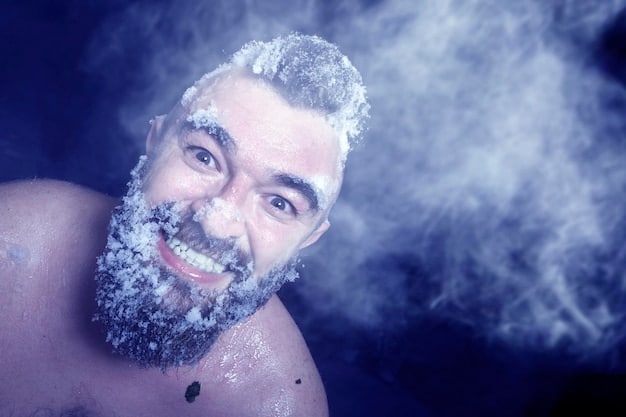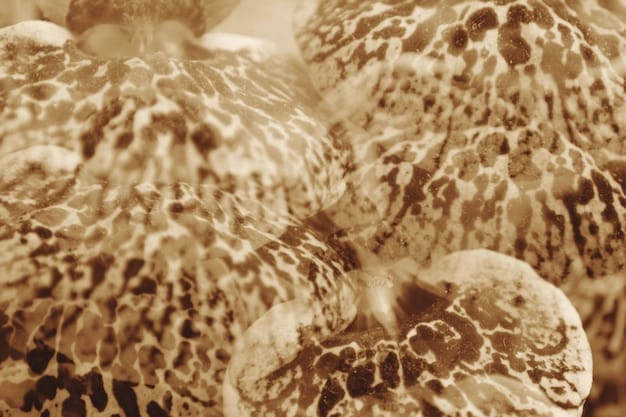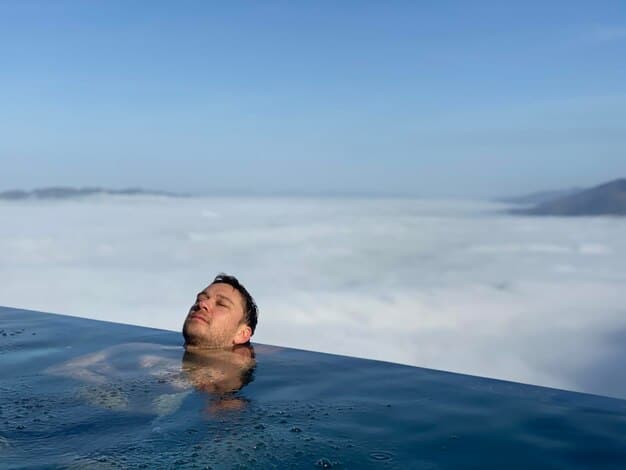Unlock the Power of Cold Exposure: Metabolism Boost & Inflammation Reduction

Cold exposure offers surprising benefits, including a potential 7% metabolism boost and significant inflammation reduction by activating brown fat and improving immune function. This practice ranges from cold showers to ice baths, influencing overall wellness.
Discover the invigorating power of cold exposure and how it can revolutionize your well-being by boosting your metabolism by up to 7% and significantly reducing inflammation, leading to a healthier and more resilient you.
The Science Behind Cold Exposure
Cold exposure, also known as cold thermogenesis, involves exposing your body to cold temperatures to trigger various physiological responses. This practice can range from taking cold showers to ice baths, and it has gained popularity due to its potential health benefits, including metabolic enhancement and inflammation reduction.
What Happens to Your Body in the Cold?
When your body is exposed to cold, it activates several key mechanisms to maintain its core temperature. These responses include shivering, vasoconstriction (narrowing of blood vessels), and the activation of brown adipose tissue (BAT), also known as brown fat.
The Role of Brown Fat
Brown fat is a special type of fat tissue that generates heat by burning calories. Unlike white fat, which stores energy, brown fat is metabolically active and plays a crucial role in thermogenesis (heat production). Cold exposure stimulates brown fat activity, leading to increased energy expenditure and potential weight management benefits.
- Increased Metabolism: Activation of brown fat can boost your metabolism by up to 7%, helping you burn more calories throughout the day.
- Improved Insulin Sensitivity: Cold exposure may enhance insulin sensitivity, which is beneficial for blood sugar control and reducing the risk of type 2 diabetes.
- Enhanced Fat Burning: By increasing brown fat activity, cold exposure can promote the breakdown of stored fat for energy.
In essence, the science behind cold exposure showcases a cascade of beneficial physiological responses, from activating brown fat to enhancing metabolic functions. These effects contribute to the overall wellness benefits associated with activities like ice baths and cold showers.

Benefits of Cold Exposure on Metabolism
One of the most compelling benefits of cold exposure is its ability to boost your metabolism. This metabolic enhancement is primarily due to the activation of brown adipose tissue (BAT), which plays a significant role in energy expenditure and overall metabolic health.
How Cold Exposure Activates Brown Fat
When exposed to cold temperatures, your body activates brown fat to generate heat. This process, known as thermogenesis, involves burning calories, which in turn increases your metabolic rate. Regular cold exposure can lead to an increase in both the activity and amount of brown fat in your body.
Metabolic Rate Increase
Studies have shown that cold exposure can increase your metabolism by up to 7%. While this may seem like a modest increase, it can have a significant impact on your long-term weight management efforts and overall energy levels. Increased metabolism means your body is more efficient at burning calories, even when at rest.
- Improved Energy Expenditure: Regular cold exposure helps your body burn more calories throughout the day, aiding in weight management.
- Enhanced Glucose Metabolism: Brown fat activation can improve glucose metabolism, helping to regulate blood sugar levels and reduce insulin resistance.
- Increased Fat Oxidation: Cold exposure promotes the breakdown of stored fat for energy, contributing to fat loss.
In summary, the impact of cold exposure on metabolism is substantial, primarily through the activation of brown fat. This leads to increased energy expenditure, improved glucose metabolism, and enhanced fat oxidation, all contributing to a healthier metabolic profile.
Reducing Inflammation with Cold Exposure
Beyond its metabolic benefits, cold exposure is also a powerful tool for reducing inflammation in the body. Chronic inflammation is linked to a variety of health issues, including autoimmune diseases, heart disease, and certain types of cancer. Cold exposure can help mitigate these risks by modulating the body’s inflammatory response.
The Inflammatory Response
Inflammation is a natural response to injury or infection. However, chronic inflammation occurs when the body’s inflammatory response becomes prolonged, leading to tissue damage and various health problems. Cold exposure can help regulate this response by reducing the production of pro-inflammatory cytokines.
How Cold Exposure Reduces Inflammation
Cold exposure triggers the release of anti-inflammatory substances and can decrease the levels of pro-inflammatory cytokines in the body. This modulation of the inflammatory response can have numerous health benefits, including reduced pain, improved immune function, and decreased risk of chronic diseases.
- Decreased Pain and Swelling: Cold exposure helps reduce pain and swelling associated with injuries and inflammatory conditions.
- Improved Immune Function: By modulating the inflammatory response, cold exposure can enhance immune function and reduce the risk of autoimmune diseases.
- Reduced Risk of Chronic Diseases: Lowering chronic inflammation can decrease the risk of heart disease, diabetes, and certain types of cancer.
To conclude, cold exposure offers significant benefits in reducing inflammation. By modulating the body’s inflammatory response, it can decrease pain and swelling, improve immune function, and lower the risk of chronic diseases.
Practical Ways to Incorporate Cold Exposure
Incorporating cold exposure into your daily routine doesn’t require drastic measures or extreme discomfort. There are several practical and accessible ways to experience the benefits of cold thermogenesis, ranging from simple cold showers to more immersive ice baths.
Cold Showers
One of the easiest ways to start with cold exposure is by taking cold showers. Begin by gradually lowering the water temperature at the end of your regular shower until it becomes cold but tolerable. Aim for 1-3 minutes of cold water exposure.
Ice Baths
For a more intense cold exposure experience, consider taking ice baths. Fill a tub with cold water and add ice until the temperature reaches around 50-60°F (10-15°C). Start with short intervals of 1-2 minutes and gradually increase the duration as you become more comfortable.
Other Methods
In addition to cold showers and ice baths, there are other ways to incorporate cold exposure into your routine, such as cold-water swimming or spending time in cold environments. The key is to gradually acclimate your body to the cold to avoid shocking your system.

- Consistency is Key: Aim for regular cold exposure sessions, such as daily cold showers or weekly ice baths, to maximize the benefits.
- Listen to Your Body: Pay attention to how your body responds to cold exposure and adjust the duration and frequency accordingly.
- Combine with Breathing Techniques: Enhance the benefits of cold exposure by combining it with deep breathing exercises, such as the Wim Hof Method.
In summary, integrating cold exposure into your daily routine is achievable through methods like cold showers, ice baths, and cold-water swimming. Consistency and listening to your body are crucial for maximizing the benefits and ensuring a safe experience.
Safety Precautions and Considerations
While cold exposure offers numerous health benefits, it’s essential to practice it safely to avoid potential risks. Understanding the precautions and considerations associated with cold thermogenesis will help you experience the benefits without adverse effects.
Consult Your Doctor
Before starting any cold exposure regimen, consult your doctor, especially if you have underlying health conditions such as cardiovascular issues, Raynaud’s syndrome, or respiratory problems. Cold exposure can affect blood pressure and heart rate, so it’s crucial to ensure it’s safe for you.
Start Slowly
Begin with short durations and gradually increase the length of your cold exposure sessions. This allows your body to adapt to the cold and reduces the risk of hypothermia or cold shock. Start with cold showers before moving on to ice baths.
Avoid Alcohol and Certain Medications
Avoid consuming alcohol before cold exposure, as it can impair your body’s ability to regulate temperature. Certain medications can also affect your response to cold, so discuss any potential interactions with your healthcare provider.
- Never Expose Yourself Alone: Always have someone nearby when taking ice baths or engaging in other forms of extreme cold exposure.
- Warm Up Properly: After cold exposure, warm up gradually to avoid putting undue stress on your cardiovascular system.
- Listen to Your Body: Pay attention to any signs of discomfort or distress and stop if you feel unwell.
In conclusion, exercising caution is paramount for successful practicing cold exposure. Consulting with your doctor, starting slow, and avoiding alcohol are critical measures to ensure both safety and effectiveness while exploring cold thermogenesis.
Enhancing Wellness with Cold Exposure: Long-Term Strategies
To maximize the long-term wellness benefits of cold exposure, it’s important to incorporate it strategically into your lifestyle. Consistent practice, combined with other healthy habits, can lead to significant improvements in your overall health and well-being.
Establish a Routine
Set a regular schedule for cold exposure, whether it’s daily cold showers or weekly ice baths. Consistency is key to reaping the long-term benefits, such as improved metabolism and reduced inflammation. Make it a non-negotiable part of your wellness routine.
Combine with Other Healthy Habits
Cold exposure is most effective when combined with other healthy habits, such as a balanced diet, regular exercise, and adequate sleep. These synergistic effects can amplify the benefits of each practice, leading to greater improvements in your health.
Track Your Progress
Keep a journal to track your cold exposure sessions and monitor any changes in your health and well-being. Note improvements in energy levels, mood, pain, and overall physical performance. This will help you stay motivated and fine-tune your approach.
- Progressive Overload: Gradually increase the duration or intensity of your cold exposure sessions over time to continue challenging your body and maximizing the benefits.
- Mindful Practice: Pay attention to your breath and mental state during cold exposure to enhance the mind-body connection and reduce stress.
- Stay Informed: Stay up-to-date with the latest research on cold exposure and adapt your practice accordingly to optimize your results.
Ultimately, consistently incorporating cold exposure, blending it with healthy lifestyle choices, and journaling your progress is essential. As you remain informed about cold exposure research, you can strategically refine your strategy to maximize effects on your overall wellness.
| Key Point | Brief Description |
|---|---|
| 🔥 Metabolism Boost | Increases metabolism by activating brown fat. |
| ⬇️ Inflammation Reduction | Lowers inflammation by modulating inflammatory response. |
| 🚿 Cold Showers | Easy way to start; aim for 1-3 minutes. |
| 🧊 Ice Baths | More intense; start with 1-2 minutes at 50-60°F. |
FAQ: Cold Exposure
▼
Cold exposure involves intentionally exposing your body to cold temperatures. This can be achieved through methods like cold showers, ice baths, or outdoor activities in cold weather, aiming to trigger beneficial physiological responses.
▼
Cold exposure activates brown adipose tissue (BAT), also known as brown fat. BAT burns calories to generate heat, which increases your overall metabolic rate, helping you burn more calories throughout the day.
▼
Yes, cold exposure can reduce inflammation by decreasing the production of pro-inflammatory cytokines in the body. This process may help alleviate pain, improve immune function, and lower the risk of chronic diseases linked to inflammation.
▼
Cold exposure is not safe for everyone. Consult your doctor before starting, especially if you have conditions like cardiovascular issues, Raynaud’s syndrome, or respiratory problems. Always start slowly and listen to your body’s signals.
▼
The frequency of cold exposure depends on your tolerance and goals. Start with short sessions, such as 1-3 minutes of cold showers daily, or 1-2 minutes in an ice bath weekly, and gradually increase as you become more comfortable.
Conclusion
Embracing cold exposure, whether through quick showers or ice baths, can be a surprisingly effective approach to enhance both your metabolic function and reduce inflammation. Remember to start slowly, listen to your body, and, when in doubt, consult with a healthcare professional. With consistent and mindful practice, cold exposure can be a valuable addition to your wellness toolkit.





